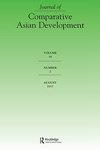Property Prices and Housing Affordability in China: A Regional Comparison
Q3 Social Sciences
引用次数: 12
Abstract
Abstract This study explores two issues related to China's property market dynamics. First, it examines how regional property price disparity is caused by space and capital market differentials, based on the Four-Quadrant Framework. With the panel data fixed effect model of 35 major cities from 2002 to 2012, it integrates regional factors, or the economic and demographic conditions in Quadrant I, into the Four-Quadrant framework. The empirical results suggest that in the coastal cities the capital market plays a bigger role in determining housing price while in the inner cities, the space market plays a bigger role. Second, the housing affordability indicator is modified by considering the impacts of household disposable income and urban population density on households' ability to purchase a home, which is in line with the first issue, to integrate economic and demographic conditions into investigating housing price dynamics. Comparing regional disparity, the eastern cities have higher housing affordability conditions than the central and western cities. The main reason is that the eastern cities have attracted human capital inflow from the central and western regions, resulting in a clustering effect for the coastal regions and a hollowing-out effect for the inland regions. The analysis has implications for investors and the government.中国房地产价格与住房负担能力:区域比较
本研究探讨了与中国房地产市场动态相关的两个问题。首先,基于四象限框架,研究了空间和资本市场差异对区域房地产价格差异的影响。利用2002 - 2012年35个主要城市的面板数据固定效应模型,将区域因素,即第一象限的经济和人口状况,整合到四象限框架中。实证结果表明,在沿海城市,资本市场对房价的决定作用更大,而在内陆城市,空间市场的决定作用更大。其次,与第一个问题一致,对住房负担能力指标进行了修正,考虑了家庭可支配收入和城市人口密度对家庭购房能力的影响,将经济和人口条件纳入房价动态调查。比较地区差异,东部城市的住房负担能力条件高于中西部城市。主要原因是东部城市吸引了中西部地区的人力资本流入,造成沿海地区的集聚效应和内陆地区的空心化效应。这一分析对投资者和政府都有影响。
本文章由计算机程序翻译,如有差异,请以英文原文为准。
求助全文
约1分钟内获得全文
求助全文
来源期刊

Journal of Comparative Asian Development
Social Sciences-Political Science and International Relations
CiteScore
1.30
自引率
0.00%
发文量
2
期刊介绍:
The Journal of Comparative Asian Development (JCAD) aims to offer the most up-to-date research, analyses, and findings on the many aspects of social, economic, and political development in contemporary Asia conducted by scholars and experts from Asia and around the world.
 求助内容:
求助内容: 应助结果提醒方式:
应助结果提醒方式:


